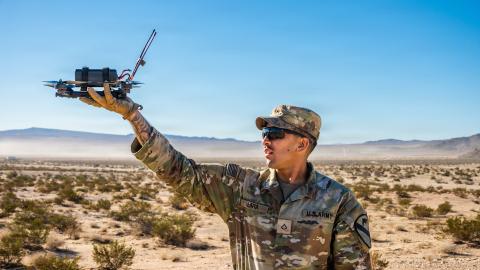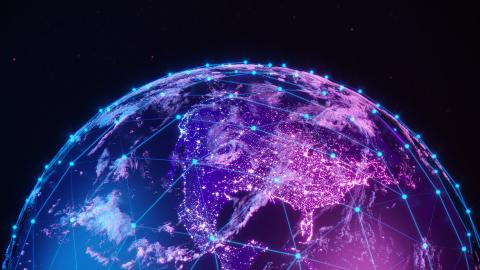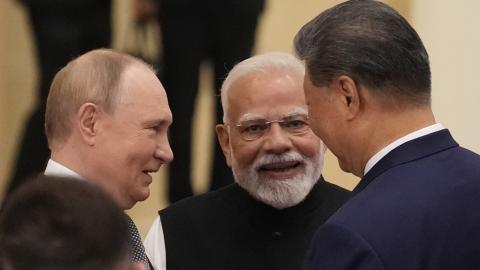In a nutshell
- India is rebalancing its foreign policy amid U.S. unpredictability
- Moscow’s ties with Beijing complicate New Delhi’s partnership with Russia
- India seeks to preserve strategic autonomy through cautious engagement
Since its creation in 2001, the Shanghai Cooperation Organization (SCO) had seldom drawn the kind of attention generated by its 2025 summit in Tianjin. The event featured the first high-level meeting in seven years between Indian Prime Minister Narendra Modi and Chinese President Xi Jinping. There were photo-ops and conversations between Prime Minister Modi, President Xi and Russian President Vladimir Putin.
The geopolitical and geoeconomic chaos resulting from a semi-isolationist and mercurial American presidency has created an opportunity for China and Russia to reach out to rising powers like India. A reset in India-China relations and a renewed “Russia-India-China” trilateral is now on the table. The future of this “Triple Entente” will depend on how President Donald Trump handles the U.S.-India partnership, how China approaches longstanding disputes and how Moscow calibrates its agenda.
India’s relations with China
Five years after their last major border clash, relations between China and India have improved markedly. Ever since the start of the second Trump presidency, China has cultivated the image of a benign global power reaching out to every country facing trade-related pressure from the U.S. This includes India – an American ally, and a key member of the U.S.-led Indo-Pacific strategy and Quadrilateral Security Group along with Australia and Japan.
Relations between the world’s two most populous countries – both nuclear powers – have always been complicated. China ranks among India’s top trading partners and frequently aligns with it in multilateral fora, yet remains New Delhi’s main strategic rival, a dynamic dating back to the 1950s.
The two countries share a 3,488-kilometer border – the longest disputed frontier between two states. Beijing has long resented India’s decision to grant asylum to the Dalai Lama and thousands of Tibetan refugees. New Delhi remains extremely concerned about strategic encirclement by China through expansion of influence over India’s neighbors.
Even though China has resolved border disputes with several adjacent countries, it has been reluctant to do the same with India. The two fought a war in 1962, ending in a clear Indian defeat. Three decades later, they signed a border agreement. But, as the gap between their economic and military power widened, China became increasingly willing to assert itself.
From 2012 onward, China has repeatedly taken small parcels of land along the largely undemarcated Himalayan frontier. Beijing is now claiming large parts of Indian territory, including Ladakh in India’s northwest and the entire state of Arunachal Pradesh in the northeast.
After the 2020 Galwan Valley clashes, relations between the two countries became more fraught. Prime Minister Modi and President Xi avoided meeting at multilateral venues. When India hosted the G20 summit in 2023, President Xi did not attend. This changed with the Tianjin summit, when the two leaders met, referred to each other as “development partners not rivals,” and spoke of the need for “mutual respect, mutual interest and mutual sensitivity.”
There has also been progress on the border issue. In October 2024, four and a half years after multiple rounds of negotiations, the two nations signed an agreement to deescalate hostilities around the line of control. It was clear that both sides wanted to ease tensions ahead of the American presidential elections.
Since January, there have been several high-level meetings between Indian and Chinese counterparts. In late August, Chinese Foreign Minister Wang Yi visited India and spoke of exploring “the possibility of advancing boundary demarcation negotiations.” The Indian side referred to it as a conversation on “de-escalation, delimitation and boundary affairs.”
Flights between the two countries have resumed after a five-year hiatus. Visa issuance has been reinstated, with China once again permitting Indian pilgrims to visit Lake Mansarovar, sacred in Hinduism.
On the economic front, there are signs that the two may cooperate, albeit cautiously. China is one of India’s top trading partners, but the balance of trade remains heavily tilted against New Delhi. As the latter seeks to build its industrial base, it is also dependent upon “the factory of the world” for supplying everything from spare parts to industrial equipment.
After the 2020 clashes, India insisted that trust needed to be restored on the border front before the normalization of diplomatic and economic relations. The Indian government heightened its scrutiny of Chinese investments and banned TikTok and other Chinese apps. Beijing recalled Chinese engineers working at Apple factories in India and halted export of industrial equipment and byproducts.
In July, after five years of export curbs on equipment critical to India’s manufacturing, China agreed to export fertilizers, rare earth magnets and minerals, and tunnel-boring machines. New Delhi has stated that it would be open to more investment from China, in limited sectors. Both countries would benefit from stronger economic ties, but structural obstacles persist at the security and strategic levels.
Whether they can forge a pragmatic relationship, even if in the short term, will depend upon whether Chinese leadership is willing to resolve the border dispute and assuage Indian concerns about strategic encirclement.
India’s relations with Russia
India’s decades-old relationship with Russia has long frustrated Washington, but now it is beginning to strain the foundations of the U.S.-India partnership. In the eyes of the second Trump administration, Russia is a “dead economy,” and India’s purchase of oil and defense equipment is enabling Russia’s war on Ukraine. For New Delhi, Moscow remains a major power with the world’s largest nuclear arsenal, a United Nations Security Council veto, a massive military and a vast arms industry.
Russia remains one of the top defense suppliers to India, with France, Israel and the U.S. vying for the next few spots. Since 2000, India has bought nearly $40 billion in Russian arms. Purchasing from Russia builds strategic leverage, from New Delhi’s perspective. That the equipment is cheaper is an added advantage.
Similarly, Russian oil and natural gas – sold at favorable prices under a price cap – is a welcome source of energy for India, which depends on external sources for 80 percent of its energy requirements.
Ever since the Sino-Soviet split of 1966, Moscow has been viewed by Indian strategists as India’s counterbalance to China on the Asian continental landmass. India views China as a threat on both land and sea, yet considers itself better positioned in the Indian Ocean thanks to the presence of allied navies. On the continental front, India views itself as facing a one (China) or two-front (China and Pakistan) war all on its own.
India’s nightmare scenario is a close Sino-Russian relationship of the kind that existed prior to the 1966 split. Modern India’s only wartime defeat came in 1962, when the Soviet Union sided with Beijing rather than New Delhi. India would like to avoid such a situation again. For Russia to serve as the continental counterweight India envisions, it cannot become a China-dependent regional power incapable of projecting influence in ways that align with Indian interests.
Yet the “no-limits” partnership between China and Russia has made it harder for India to pull Moscow out of Beijing’s orbit. A February 2025 interview with Russia’s ambassador to India, in which he said Moscow would remain neutral in the event of an India-China war, along with Russia’s stance during the recent clash with Pakistan, clearly showed that limitation.
Still, India maintains close ties with Russia, and is its partner in BRICS, SCO and the G20. New Delhi views this as a strategic step to curb Chinese dominance within these groupings, and endeavors to keep its own interests on Moscow’s radar.
Scenarios
India’s ideal environment is a multipolar world order in which New Delhi can exert significant leverage. India’s top diplomat, Subrahmanyam Jaishankar, described Russia, China and India as “three big Eurasian powers” in an interview with The Economist and declared, “This is not transactional. This is geopolitical.” Despite three decades of deepening ties with the U.S. and the West, this alignment is unlikely to shift under pressure from the Trump administration.
Most likely: Continued cooperation with the West as well as Russia and China
The most likely scenario is that India will continue to cooperate with the West and sustain its strategic partnership with the U.S., while preserving its close ties with Russia and China. The Russia-India-China Triple Entente is not intended as an anti-Western or anti-American bloc, but rather reflects India’s assessment of its geopolitical imperatives.
This could change, however, if the current downward trajectory in U.S.-India relations persists and if President Trump’s criticism of India extends beyond trade to national security. New Delhi would likely react strongly to any U.S. move to treat India and Pakistan as a single policy framework, intervene in the Kashmir dispute or resume military assistance to Karachi.
Any attempt by the U.S. to intervene in India’s backyard remains anathema to New Delhi. If this happens, and China – sensing an opportunity – makes India an offer on resolving their border dispute, then a major reset in India-China ties is possible. Beijing has signed border agreements with several of its neighbors, but not with India − yet. A Chinese proposal, perhaps with economic incentives, appears unlikely but could lure India away from the U.S. camp.
Least likely: New Delhi fully embraces a Russia-India-China alliance
A Russia-India-China partnership in which India trusts both these partners fully remains the least likely scenario. India seeks a multipolar order whereas Russia wants a return to a bipolar world. Meanwhile China wants to become the undisputed global hegemon.
India and China both see themselves as civilizational states and key Asian powers, with clashing spheres of influence. It will take more than a summit meeting or two to get over that divergence.














